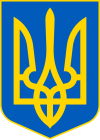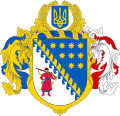Trysub
The Trysub is a common figure in heraldry and is almost only found on Ukrainian coats of arms and flags (for example, war flags ).
The trident , as the name can be translated, is a national symbol of Ukraine . A golden Trysub is shown in blue. The symbol has already been depicted on coins of the Kievan Rus . Around 862 it was the Varangian prince Rurik , a founder of the dynasty named after him, who is considered to be the founder of the first East Slav empire, from which the Ukraine emerged alongside Russia and Belarus . Over time, the sign has developed into its current form. Used again by the Cossacks in the 17th century, it became the symbol of the Ukrainian People's Republic from 1918 to 1921 .
It was not tolerated during the Soviet Union . In the time of National Socialism, the use of the Trysub by nationalists moved into twilight.
Today the coat of arms is not only shown on the national coat of arms, but also on many coats of arms of the oblasts , postage stamps , coins and banknotes . The presidential standard also carries the mark.
For the coat of arms in its valid form, the coat of arms figure was created in 1918 by the artist Wassyl Krytschewskyj .
The symbol gave its name to the Tryzub newspaper published in Paris .
Coat of arms with the Trysub
Banknote from 2003 (5- hryvnia )
At the Ministry of Foreign Affairs of Ukraine, the Trysub replaced the Soviet emblem on the exterior facade.
Coat of arms with the Trysub outside Ukraine
See also
literature
- Wilfried Jilge (Hrsg.): Historical culture of the Ukraine as reflected in the Ukrainian bookplate art of the 20th century. Leipziger Universitäts-Verlag GmbH, Leipzig 2003, ISBN 3-936522-92-8 .
Individual evidence
- ^ Ernst Lüdemann: Ukraine (= Beck'sche series 860 countries ). 3rd, completely revised edition. CH Beck oHG, Munich 2006, ISBN 3-406-54068-6 , p. 20.
- ↑ a b Günther Schäfer: Discover Kiev. Tours through the metropolis on the Dnepr. 2nd updated edition. Trescher, Berlin 2007, ISBN 978-3-89794-111-3 , pp. 69, 128.









